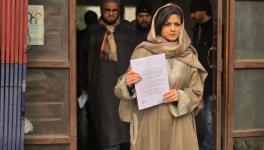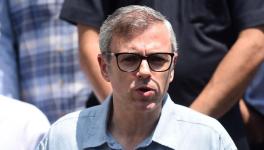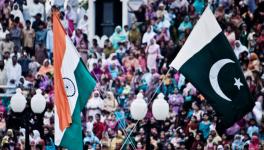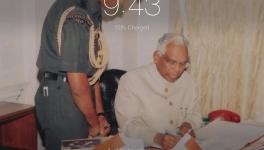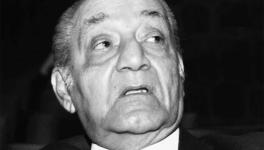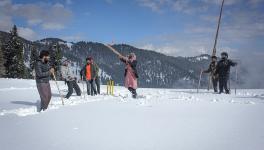The Tipping Point: New Delhi Now Faces Not Terrorists, But the Young Kashmiri Masses
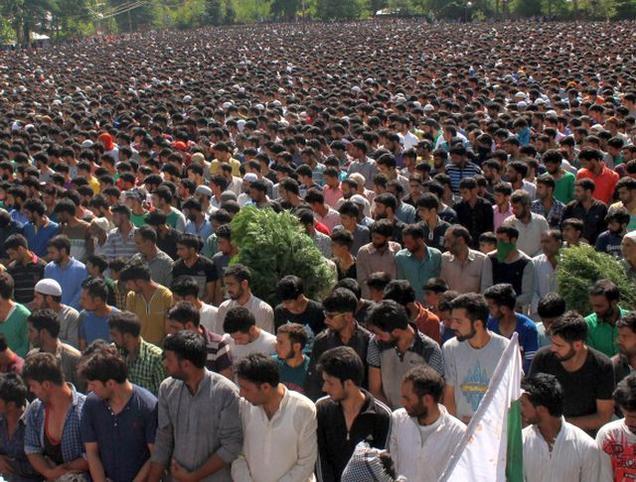
Funeral of Burhan Muzaffar Wani in Tral, Near Srinagar
The death of 22 year old Burhan Wani in an encounter is the tipping point for Kashmir. The thousands who walked miles to attend his funeral at Tral are testimony to the shift, as mobs after 20 years attacked government vehicles and installations in what constituted large scale violence for a Valley under curfew and strict restrictions.
What started in 2010 has blown into open defiance and alienation that will not take a step back. The windows have been shut, the doors bolted and secured by the Kashmiris who in this open mourning on an unprecedented scale for a Hizbul militant have sent out a signal that there is no space now for the state or the centre to be heard. The trust being sniped at since 2010 and again since the new government came to power in Jammu and Kashmir has shattered, with the moderate Kashmiris now maintaining that there is no one left to talk to, and nothing left to talk about.
Take the clock back to 2008 when the National Conference came to power with the Congress party, and Omar Abdullah became the Chief Minister of Jammu and Kashmir. The young people, seeking to move out of the inheritance of conflict that most had grown up with, saw hope in the young leader. Many of them told this writer then, and subsequently, as to how he had inspired trust, and the youth at least were preparing to shed the baggage and move into the world of opportunity that Omar Abdullah had promised during his election campaign. Because he appeared different and sincere, they believed him, and the vote was positive as was the turn out. Young Kashmiri entrepreneurs in particular, were optimistic of trade and business booming under Omar Abdullah and his litany of promises.
It has to be stated that this generation of young Kashmiris were anti-Pakistan at the time, a big shift in the Valley where older generations had been looking towards the neighbouring country for so called liberation. The disillusionment with Pakistan was running deep in 2008-2010, creating an environment where positive intervention by New Delhi could have helped build bridges.But then there was no one in Delhi willing to listen to even their own intelligence reports from the ground.
In the two years to 2010, the Chief Minister did establish himself as a non-serious man about town, and disillusionment, always a flicker of the eye away in the Valley, started setting in. The unemployed youth felt the heat of this silent protest more, with Abdullah’s police implementing the Public Safety Act with impunity. Instead of being accessible, the Chief Minister became more inaccessible, and in 2010 when some youths vented their ire on government targets by pelting stones, the police retaliated without restraint.
This was the first time stone pelting came into widespread use on the streets of Kashmir, with young people from all walks of life joining in to vent their anger. This was not serious, it did not have any underlying strain of terror or extremism, and while profiling the stone pelters at the time this reporter was interested to find that all the youth interviewed said that they were doing this to attract the government’s attention. It was as many reported at the time, a cry for attention by the young largely unemployed Kashmiris.
The Congress government’s first reaction at the centre was ‘terrorism’. This changed finally to a kinder response in the face of evidence from its own intelligence agencies, that the stone pelters were not terrorists or affiliated with any extreme organisations. But this was too late and by the time this realisation sunk in the damage had been done. The first death of a teenager in police firing had been reported, and from then on it was a tragic and terrifying wave of protests, and firing, and deaths and more protests.
This was the turning point for the younger generation. A realisation, reinforced by the ‘we told you so’ of the elders that New Delhi was not keen to mend bridges, that Omar Abdullah was unable or unwilling or both, and that there was no real hope.Yet the anger had not turned into despair, as there was an active Peoples Democratic Party acting as a release valve. Mehbooba Mufti rushed around offering solace, political leaders and civil society from Delhi tried to reach out, and there was some movement that offered hope even in that anger.
Interestingly at the time Union Minister P.Chidambaram was one of the main obstacles in the way of rapprochement, and controlled the media directly to prevent full and fair reportage of Kashmir. 14 political parties had mobilised a big event in New Delhi to demand, amongst other things, the demilitarization of Jammu and Kashmir. The entire media was present, but not a word was reported as if a signal had been sent out to the television channels not to report a word of what was unprecedented unity on a sensitive issue.
An opportunity, provided from within Kashmir, was thus lost because of the old mind sets, and conservative responses of the state.
In the last Assembly elections, the young voters disillusioned but not despairing voted in large numbers for PDP. Taken in by its campaign promises to keep the BJP out, the vote consolidated behind Mufti and his daughter. The reverse after the elections created unease to begin with, that turned to anger with what bared itself as an anti-Kashmir agenda. This came with statements on sensitive issues, not with debate, but in the form of what the Valley perceived as threats on their future through:
1.Segregated colonies for Kashmiri pandits;
2. Segregated colonies for the Army;
3. Attack on Article 370, that the Kashmiris perceive as the last fig leaf holding the Delhi-Srinagar agreements together;
4. Repeated, unprovoked support of AFSPA;
5. Attacks on Kashmiri students studying outside the Valley;
6. Abuse by trolls on the social media, that becomes threatening and communal;
7. Disruption of talks with Pakistan, that are seen necessary in Jammu and Kashmir for normalisation and peace;
The situation has since turned from bad to worse. The Citizen has been reporting steadfastly on the protests in the Valley, becoming larger by the day, more frequent, more angry, more despairing with the protestors ---after a long gap of many years---waving Pakistani flags. And more recently Islamic State flags. Again after a long period, mourners are coming out in large numbers after the death of alleged militants by security forces. This had stopped after the decade of militancy, with the Kashmiris by and large staying away from such funerals.
The ‘martyrdom’ of Burhan Wani declared by his father who has lost two sons, and says he is prepared to lose his third, indicates a big shift within Kashmir. The huge crowd at Burhan Wani’s funeral confirms this shift, with the protests targeting government installations and personnel regardless of the consequences. 16 have died, and the anger that usually subsides after such violence, is still pouring out on the streets and in the social media.
The difference between today and the 1990’s decade of violent militancy and an equally violent state response, is that it will not be the terrorists from across the border who will be driving the protests and the agenda. It will be the Kashmiri youth, the majority of whom are not affiliated with any terror organisation. They are actually a loose mass of young people----seen together in unity in 2010, and again during the floods in Kashmir, and yet again today---who do not have a formal organisation or body or leadership but who come together within seconds through a grapevine that now does not only rely on the internet as these services are snapped frequently in the Valley, to fight for their lives.And for what more and more of them have started describing as their ‘nation’.
It is difficult to fight them with weapons without large scale casualties. It is impossible to fight them with the old tactics of encounters and army action as the world is watching.
The choice before the Indian state is exactly what it was before. To mow down the young Kashmiris with bullets, in large numbers now as the protests are not likely to stop. And hope to manage international opinio in the wake of what will be construed as state violence across the world.
Or to reach out to break down barriers ---that will take some doing in a communally charged environment outside the state---open the doors, and take immediate remedial measures if possible. This seems impossible as the BJP cannot defy its own anti-Kashmir constituency beyond a point, and the Kashmiris themselves are seemingly in no mood to unbolt their doors.
A quagmire of our own making?
Image Courtesy: The Hindu
Courtesy: thecitizen.in
Disclaimer: The views expressed here are the author's personal views, and do not necessarily represent the views of Newsclick.
Get the latest reports & analysis with people's perspective on Protests, movements & deep analytical videos, discussions of the current affairs in your Telegram app. Subscribe to NewsClick's Telegram channel & get Real-Time updates on stories, as they get published on our website.









